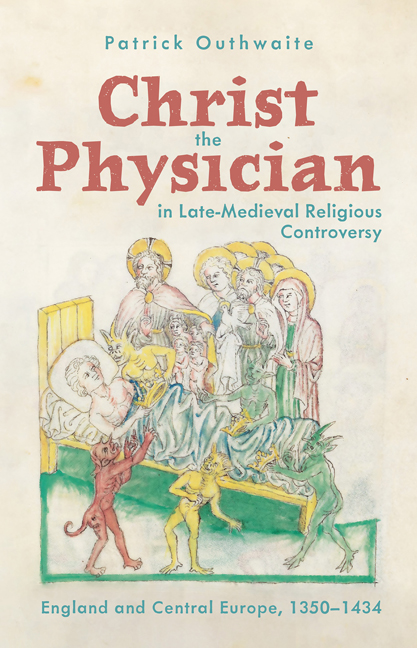Book contents
- Frontmatter
- Dedication
- Contents
- List of Illustrations
- Acknowledgements
- List of Abbreviations
- Introduction: The Christus medicus Tradition
- 1 The Virgin Mary as Nurse, Medicine and Mother: Devotional Texts and Hospitals
- 2 Sacramental Medicine and Frequent Communion from Prague to Kraków
- 3 Disenfranchised Surgeons: Christus chirurgus and Wycliffite Preaching in England
- 4 The Diseased Ecclesia from Jan Hus’s Exile to the Council of Basel
- 5 Responses to Heresy at the Councils of Constance and Basel
- Afterword
- Bibliography
- Index
- Miscellaneous Endmatter
5 - Responses to Heresy at the Councils of Constance and Basel
Published online by Cambridge University Press: 09 May 2024
- Frontmatter
- Dedication
- Contents
- List of Illustrations
- Acknowledgements
- List of Abbreviations
- Introduction: The Christus medicus Tradition
- 1 The Virgin Mary as Nurse, Medicine and Mother: Devotional Texts and Hospitals
- 2 Sacramental Medicine and Frequent Communion from Prague to Kraków
- 3 Disenfranchised Surgeons: Christus chirurgus and Wycliffite Preaching in England
- 4 The Diseased Ecclesia from Jan Hus’s Exile to the Council of Basel
- 5 Responses to Heresy at the Councils of Constance and Basel
- Afterword
- Bibliography
- Index
- Miscellaneous Endmatter
Summary
To St Augustine, the term ‘cura’ signified both care and administration.1 He intended these dual but connected definitions to be the underlying principles of all the clergy's responsibilities, from overseeing the spiritual welfare of individuals and leading liturgical rites, to the highest forms of Church governance. The ecumenical councils looked to uphold these values of cura in the later Middle Ages, in which the Church faced not only the discord caused by the Great Western Schism, but also threats posed by Wycliffite and Hussite heretics. Nevertheless, the ecumenical councils did not wholly preserve the guiding principles that Augustine established. Where Augustine was adamant that the Church ‘imposes nothing by force, but everything by persuasion and admonition’, the Council of Constance (1414–18) was concerned with concepts of contamination, purgation and amputation in dealing with multiple popes and heresies. Augustine had in fact addressed ideas of contamination and pestilence in his writings on the Manichaeans, yet he insisted that the role of the Church was not to sever its infirm members, but to heal them and keep the body intact. Equally important for Augustine in his discussions of heresy was the imagery of the lost sheep returning to the flock. When the sheep returns, it is not chastised but healed:
for even the sheep that was wandering astray and had received the brand of the Lord outside the fold from its dishonest rustlers, if it comes to the security of Christian unity, it is restored from error, freed from captivity and healed of its wound, for the brand of the Lord on it is recognised rather than rejected.
For Augustine, whether one received the brand, in this context baptism, within the Church or from those considered to be heretics, it did not matter. The Lord recognised his own brand even when the sheep has been branded by another. This is not to say that heretics could re-join the flock without consequence. Augustine recognised that often the medicines that were used to correct heresy were painful, but ultimately the pain was endured to keep the body of the Church united.
- Type
- Chapter
- Information
- Christ the Physician in Late-Medieval Religious ControversyEngland and Central Europe, 1350-1434, pp. 201 - 226Publisher: Boydell & BrewerPrint publication year: 2024



